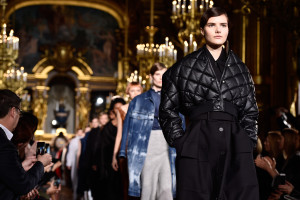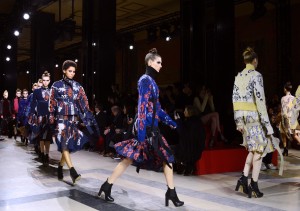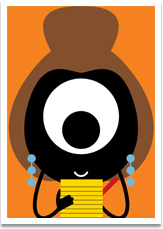Two designers are presenting nuanced collections with subtle statements on how to balance the lives of women in the modern world. Although both offer clothes that women will want to wear, they also show that they understand women’s lives are more complex than ever.
Stella McCartney is a designer who believes that an eye – and an earring – can “do it all”, meaning that crazily busy women’s lives demand an outfit that can go from morning to night with just a change of jewel and of attitude.
Standing backstage, with her model friend Amber Valletta, Stella explained her philosophy, although that sounds a grand word to describe a bold puffer coat, a big dress frilled at the chest, and denim, splattered with a bleached pattern of white intruding on blue.
Then the swans sailed in, curlicues of the stately birds with their heads held high, another pattern drawn from nature, just as in the past the designer has used images of fruit or flowers.
I caught Stella backstage, joshing about with her model friend Amber Valletta and asked about the swans.
“It felt very British to have swans – it’s in my language and heritage to have some kind of animal print or some kind of respect for my fellow creatures,” she said. “So the swan was there, in a really playful way, in a bold way, mixed up with all the elements that we have done for many years to give women their wardrobes.
I don’t know the methodology of Stella’s collections as she rolls them out, but there seems to be a three-pronged attack: shape, texture and colour. The show started with velvet, so fashionable for the winter 2016 season, but padded to blend in with the puffer coats. Trousers may not have had the same depth of detail, but the show moved seamlessly through the day into evening, with silken dresses inset with lace as an after-dark look.
But, true to her spirit, everything was mashed up: the swan-print trousers with a tweedy jacket; then more velvet, but this time as a suit, with the shoulders and bust reduced to transparent lace over a silver top.
I thought about the so-very-fashionable current gender-neutral style and realised that Stella takes a different approach. Instead of making similar clothes for men and women, she often brings the male and female side together in a single outfit in her womenswear collections. The effect is modern, with a throwaway energy and a sense of female freedom, whether the client is an ugly ducking or a swan.
The story of the Sacai brand started from the back. Make that “backs”, because the Japanese designer Chitose Abe built her reputation in Paris on her two-way designs: the front rigorously different from the back.
But since she dropped that method of showing different skills using fabric and decoration, a strange thing had happened. Her clothes seem more complicated, with strings dangling from fastenings and all kinds of embellishment. There were black prints on an ochre tunic and skirt; ridges of fabric showing quilted effects shaped across the bodice; skirts in ruches of black chiffon revealing the tiniest peek of skin.
It was quite a relief when the models turned round and showed – nothing. Or to be more accurate, bare skin lightly veiled in chiffon.
The designer was wise to drop her signature back/front idea before it became a bore. But I never felt that about her technique – there was a charm in recognising that a woman has different qualities and feelings, at the same time.
If the Sacai show could bring back that double vision of women’s lives, it might bring back the missing charm.



